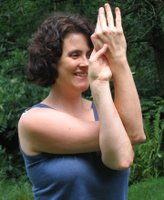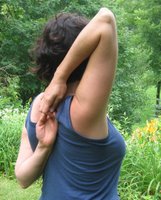One of, if not the, best part of taking a yoga class is letting yourself be lead through a series of poses that progress logically so that by the end of the session your body is completely worked and refreshed. An asana sequence is most successful when it teaches you the various elements of your target pose, but lets each step of the way challenge your body to stretch and open to its fullest. When you reach the peak of the class, your muscles and limbs naturally accept the challenge of the headstand, backbend, etc. because they have been properly prepared. 
As you become more familiar with the many of positions in hatha yoga, you will begin to see the connections between them and this will help you develop your home practice. However, until all the Sanskrit names become second nature to you, I want to suggest ways of linking warm-ups and poses so you can start sequencing on your own. Even if you read this blog to get ready-made home practice sequences, you can use this information for a quick “spot stretch” --to loosen a cramped shoulder or stretch a tight calf muscle.
Try and start with a short meditation, or few minutes of focused breathing. This can be while you are standing in Tadasana (Mountain) or sitting comfortably cross-legged in Sukhasana (Easy Pose). Let your mind release, focus on the breath and take some time to align and open the spine. From the breath and the spine, move your attention into your upper body. Consider what your target pose is going to be and think about what you need to prepare. Backbends and Shoulder Stands need warmed shoulder joints and an open chest. Headstands need energized arms and a long spine. Standing balance poses need a lifted rib cage and squared hips. Evaluate the work of the asana and what muscles are most engaged (what is sore when you finish the pose?) and work backwards to what preparations warm and stretch those parts of the body.
Hastasana (overhead arm stretch) is always a good place to start, because you get the whole torso into the act. The shoulder joints are intensely rotated, the sides of the chest stretch to keep the spine long and the hips have to balance to keep the tailbone pointing to the floor. This stretch can happen while you are standing or in Virasana (Hero), Dandasana (Staff) or Sukhasana. Make sure to keep the neck relaxed, the shoulders away from the ears and breathe evenly.
 Another option is using the arm position from Gomukhasana (Cow’s Head). This requires even more rotation in the shoulder joints, while it stretches the triceps in the upper arms and opens the chest. Try to focus on the opening of the shoulder joints and keep the neck and upper back relaxed. Also, keep the spine long and the lower back neutrally curved; it’s easy to arch when you are so focused on the arms. The arm position for Garudasana (Eagle Pose) also opens the shoulders and upper chest, but moves the stretch to the center back as the arms twist at the center front.
Another option is using the arm position from Gomukhasana (Cow’s Head). This requires even more rotation in the shoulder joints, while it stretches the triceps in the upper arms and opens the chest. Try to focus on the opening of the shoulder joints and keep the neck and upper back relaxed. Also, keep the spine long and the lower back neutrally curved; it’s easy to arch when you are so focused on the arms. The arm position for Garudasana (Eagle Pose) also opens the shoulders and upper chest, but moves the stretch to the center back as the arms twist at the center front.
If Cow’s Head and Eagle are too pretzel-y for you, the Namaste hand position in back, also opens the chest and rotates the shoulders more gently. Work to deepen the stretch in the armpits by keeping the neck long and stretching the elbows down and back, as you press your palms together behind the shoulder blades. Keep your breath even, but notice the extra stretch you can sneak in by filling the lungs and lifting the rib cage on your inhales. Tricky. Now the upper body is warm and open. You can come back Sukhasana and notice how you feel, compared to when you started. Store those observations because they will help you remember what stretch affects which muscles. This information is what will help you decide how to sequence your practice.
Next week, I’ll continue onto the hips and legs so you can develop well-rounded sequences. Until then, keep these warm-ups in mind during your next yoga class and notice which ones are echoed in the more difficult poses. And enjoy letting your teacher do the heavy thinking…

 Another option is using the arm position from Gomukhasana (Cow’s Head). This requires even more rotation in the shoulder joints, while it stretches the triceps in the upper arms and opens the chest. Try to focus on the opening of the shoulder joints and keep the neck and upper back relaxed. Also, keep the spine long and the lower back neutrally curved; it’s easy to arch when you are so focused on the arms. The arm position for Garudasana (Eagle Pose) also opens the shoulders and upper chest, but moves the stretch to the center back as the arms twist at the center front.
Another option is using the arm position from Gomukhasana (Cow’s Head). This requires even more rotation in the shoulder joints, while it stretches the triceps in the upper arms and opens the chest. Try to focus on the opening of the shoulder joints and keep the neck and upper back relaxed. Also, keep the spine long and the lower back neutrally curved; it’s easy to arch when you are so focused on the arms. The arm position for Garudasana (Eagle Pose) also opens the shoulders and upper chest, but moves the stretch to the center back as the arms twist at the center front. 
No comments:
Post a Comment